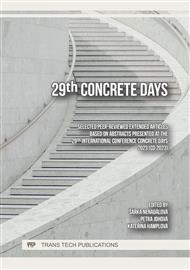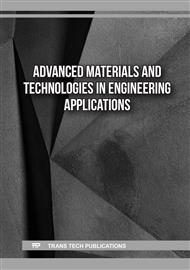[1]
Provis, J.L.; Palomo, A.; Shi, C. Advances in understanding alkali-activated materials. Cem. Concr. Res. 2015, 78, 110–125.
DOI: 10.1016/j.cemconres.2015.04.013
Google Scholar
[2]
Gandel, R.; Jerabek, J.; Marcalikova, Z. Reinforced Concrete Beams Without Shear Reinforcement Using Fiber Reinforced Concrete and Alkali-Activated Material. Civil and Environmental Engineering 2023, 19, 348.
DOI: 10.2478/cee-2023-0031
Google Scholar
[3]
Provis, J.L.; van Deventer, J.S.J. Alkali-Activated Materials, RILEM State-of-the-Art Reports; Springer: Dordrecht, The Netherlands, 2014; Volume 13, p.379, ISBN: 978-94-007-7671-5.
DOI: 10.1007/978-94-007-7672-2
Google Scholar
[4]
Bílek, V.; Sucharda, O.; Bujdoš, D. Frost resistance of alkali-activated concrete - An important pillar of their sustainability. 2021. ISSN 2071-1050.
DOI: 10.3390/su13020473
Google Scholar
[5]
Palomo, A.; Monteiro, P.; Martauz, P.; Bilek, V.; Fernandez-Jimenez, A. Hybrid binders: A jorney from the past to a sustainable future (opus caementicium futurum). Cem. Concr. Res. 2019, 124, 10582.
DOI: 10.1016/j.cemconres.2019.105829
Google Scholar
[6]
Shi, C.; Krivenko, P.V.; Roy, D. Alkali-Activated Cements and Concretes; Taylor & Francis: Milton, UK, 2006; p.376, ISBN I 0: 0-415-70004-3.
DOI: 10.4324/9780203390672
Google Scholar
[7]
Mateckova, P.; Bilek, V.; Sucharda, O. Comparative Study of High-Performance Concrete Characteristics and Loading Test of Pretensioned Experimental Beams. Crystals 2021, 11, 427.
DOI: 10.3390/cryst11040427
Google Scholar
[8]
Miarka P.; Seitl S.; Horňáková M.; Lehner P.; Konečný P.; Sucharda O.; Bílek V. Influence of chlorides on the fracture toughness and fracture resistance under the mixed mode I/II of high-performance concrete (2020) Theoretical and Applied Fracture Mechanics, 110, art. no. 102812.
DOI: 10.1016/j.tafmec.2020.102812
Google Scholar
[9]
Sucharda, O.; Marcalikova, Z.; Gandel, R. Microstructure, Shrinkage, and Mechanical Properties of Concrete with Fibers and Experiments of Reinforced Concrete Beams without Shear Reinforcement. Materials 2022, 15, 5707
DOI: 10.3390/ma15165707
Google Scholar
[10]
ČSN EN 12350-2. Testing fresh concrete - Part 2: Slump test, Prague, 2020.
Google Scholar
[11]
ČSN EN 12350-5. Testing fresh concrete - Part 5: Flow table test, Prague, 2020.
Google Scholar
[12]
ČSN EN 12350-4. Testing fresh concrete - Part 4: Degree of compactability, Prague, 2020.
Google Scholar
[13]
ČSN EN 12390-7 Testing hardened concrete - Part 7: Density of hardened concrete, Prague, 2020.
Google Scholar
[14]
ČSN EN 12390-3. Testing hardened concrete - Part 3: Compressive strength of test specimens, Prague, 2020.
Google Scholar
[15]
ČSN EN 12390-6. Testing hardened concrete – Part 6: Tensile splitting strength of test specimens, Prague, 2010.
DOI: 10.3403/30200045
Google Scholar
[16]
ČSN EN 12390-13. Testing hardened concrete - Part 13: Determination of secant modulus of elasticity in compression, Prague, 2021.
DOI: 10.3403/30397532
Google Scholar
[17]
ČSN EN 73 1326. Resistance of cement concrete surface to water and defrosting chemicals, Prague, 1984.
Google Scholar
[18]
ČSN 73 2577. Test for surface finish adhesion of building structures to the base, Prague, 1981.
Google Scholar
[19]
ČSN EN 196-1. Methods of testing cement - Part 1: Determination of strength, Prague, 2016.
Google Scholar



